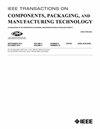Influence of Au Substrate Crystal Structure on Ag–Au Interdiffusion for WBG Packaging
IF 2.3
3区 工程技术
Q2 ENGINEERING, ELECTRICAL & ELECTRONIC
IEEE Transactions on Components, Packaging and Manufacturing Technology
Pub Date : 2025-02-25
DOI:10.1109/TCPMT.2025.3545544
引用次数: 0
Abstract
The rapid diffusion of Ag–Au usually results in weak interface joints, which significantly impacts the stability of wide bandgap (WBG) devices. Therefore, the interdiffusion mechanism at the atomic scale is essential to effectively inhibit excessive interdiffusion and ultimately achieve robust joints. Herein, die-attach samples were prepared by Au substrate with different crystal structures, in which the shear strength reached 43.5 and 34.4 MPa for Sample I and Sample II, respectively. The following crystal structures analysis confirms the sintered Sample I exhibited a higher interface connection rate (ICR) of 47% and lower Ag–Au interdiffusion thickness of求助全文
约1分钟内获得全文
求助全文
来源期刊

IEEE Transactions on Components, Packaging and Manufacturing Technology
ENGINEERING, MANUFACTURING-ENGINEERING, ELECTRICAL & ELECTRONIC
CiteScore
4.70
自引率
13.60%
发文量
203
审稿时长
3 months
期刊介绍:
IEEE Transactions on Components, Packaging, and Manufacturing Technology publishes research and application articles on modeling, design, building blocks, technical infrastructure, and analysis underpinning electronic, photonic and MEMS packaging, in addition to new developments in passive components, electrical contacts and connectors, thermal management, and device reliability; as well as the manufacture of electronics parts and assemblies, with broad coverage of design, factory modeling, assembly methods, quality, product robustness, and design-for-environment.
 求助内容:
求助内容: 应助结果提醒方式:
应助结果提醒方式:


